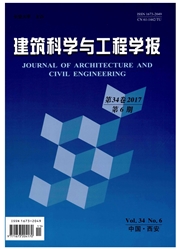

 中文摘要:
中文摘要:
基于屈服线和冲剪破坏模型,对矩形管-管节点和板-管节点发生这2种破坏模式的支主管宽度比口适用范围进行理论分析,探讨CIDECT规范中给出的支主管宽度比适用范围的合理性,并在此基础上合理考虑沿支管周长刚度变化,对主管可能发生屈服线和冲剪破坏的区域进行分析,给出屈服线和冲剪综合破坏的承载力计算方法。将所得公式的计算结果与试验结果进行对比,并将其与CIDECT规范计算公式进行对比分析。结果表明:该建议公式计算值与试验值吻合较好;β〈0.85时,CIDECT规范公式低估了节点承载能力,而0.85〈β〈1-1/γ(2γ为主管宽厚比)时,CIDECT规范公式高估了节点承载能力。
 英文摘要:
英文摘要:
Based on the yield line and punching shear model, the application scope of the width ratioβ of branch member to chord member was theoretically analyzed when the two failure modes of the rectangular tube-tube joint and the plate-tube joint happened. The rationality of application scope of the width ratio of branch member to chord member proposed in CIDECT specification was discussed. On the basis, reasonably considering the change of stiffness along branch perimeter, the regions where yield line and punching shear probably occurred were studied, and the bearing capacity calculation method of the comprehensive failure model of yield line and punching shear was proposed. The calculated results of the proposed formula were compared with the experimental results and the calculation formula of CIDECT specification. The results show that the calculated results are in good agreement with the test results. When β〈0. 85, the formula of CIDECT underestimates the bearing capacity of joint, and when 0.85〈β〈1-1/γ, (2γis the width to thickness ratio of chord member ), the formula of CIDECT overestimates the bearing capacity of joint.
 同期刊论文项目
同期刊论文项目
 同项目期刊论文
同项目期刊论文
 期刊信息
期刊信息
